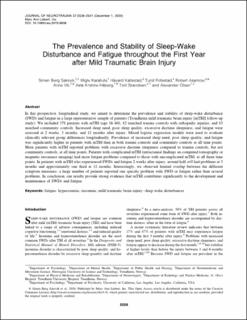| dc.description.abstract | In this prospective, longitudinal study, we aimed to determine the prevalence and stability of sleep-wake disturbance (SWD) and fatigue in a large representative sample of patients (Trondheim mild traumatic brain injury [mTBI] follow-up study). We included 378 patients with mTBI (age 16–60), 82 matched trauma controls with orthopedic injuries, and 83 matched community controls. Increased sleep need, poor sleep quality, excessive daytime sleepiness, and fatigue were assessed at 2 weeks, 3 months, and 12 months after injury. Mixed logistic regression models were used to evaluate clinically relevant group differences longitudinally. Prevalence of increased sleep need, poor sleep quality, and fatigue was significantly higher in patients with mTBI than in both trauma controls and community controls at all time points. More patients with mTBI reported problems with excessive daytime sleepiness compared to trauma controls, but not community controls, at all time points. Patients with complicated mTBI (intracranial findings on computed tomography or magnetic resonance imaging) had more fatigue problems compared to those with uncomplicated mTBI, at all three time points. In patients with mTBI who experienced SWDs and fatigue 2 weeks after injury, around half still had problems at 3 months and approximately one third at 12 months. Interestingly, we observed limited overlap between the different symptom measures; a large number of patients reported one specific problem with SWD or fatigue rather than several problems. In conclusion, our results provide strong evidence that mTBI contributes significantly to the development and maintenance of SWDs and fatigue. | en_US |

